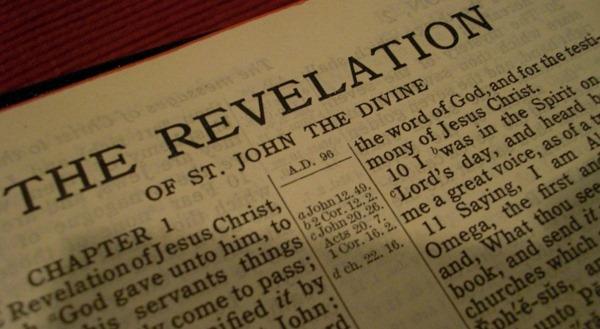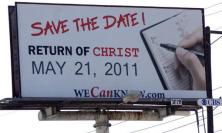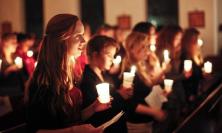Our Sunday second readings in this Easter season are taken from the Book of Revelation, one of the most challenging texts in the Bible. Peter Edmonds SJ looks closely at the extracts that we will hear over the coming weeks and suggests how they, and the book as a whole, can help us to deepen our Easter faith and joy.
Many good people admit that the Book of Revelation makes them uneasy. Its contents seem strange and alien. The narrative is difficult to follow. The symbolism of beasts that come out of the sea and of numbers written on right hands and of marks made on foreheads puzzles us. There are too many plagues and excessive violence. We seem to learn too much about angels and too little about people like ourselves. And we also know that this is a text that is continually misused by people who seek from it information about events in our own time and who speculate about the date of the end of the world.
Yet it is a biblical book and when it is read out as the ‘word of the Lord’ in our liturgy, we reply, ‘Thanks be to God’. It is the last of the biblical books, the final chapter of the whole Bible, and we are not comfortable if we fail to read the last chapter of a book. It begins and ends with the name of Christ. It is his ‘revelation’ (1:1). It concludes with an Amen, celebrating ‘the grace of the Lord Jesus’ (22:21). It promises a blessing both to those who read it and those who hear it and ‘keep what is written in it’ (1:3). All major Christian traditions acknowledge it as sacred scripture.
The Church is cautious with this book. There are only seven occasions when it is an official Sunday reading. The first is on the Feast of Christ the King in Year B of the Sunday cycle. The remainder occur on the Sundays after Easter Sunday in Year C. Let us take these seven readings as our entrance into this book. They are chosen presumably to encourage us to penetrate more deeply into the Easter mystery and to deepen our Easter faith and joy. Those who preach on Sundays might be bold enough to base their homilies on them.
New Titles for Christ (Christ the King, Year B – Revelation 1:5-8)
The book begins, ‘The revelation of Jesus Christ’, an indication that the chief subject of the book is the person of Jesus Christ. In this brief extract from the first chapter which constitutes a Prologue for the book, we have three unique titles given to Christ. He is ‘the faithful witness, the firstborn of the dead, and the ruler of the kings of the earth’. This text reminds us firstly of the witness that Christ gave, especially in the trials before the high priests and Pontius Pilate that preceded his death; and of the fact that at the beginning of the Acts, the Risen Christ sent the apostles out to be his witnesses (Acts 1:8). Secondly, as ‘firstborn of the dead’, he is a pledge of our own resurrection; Paul called him ‘the firstborn within a large family’ (Romans 8:29). He is the ‘first fruits of those who have fallen asleep’ (1 Corinthians 15:20). Thirdly, he is ‘ruler of the kings of the earth’. When this book was written, the Caesar in Rome was the most powerful man on earth. This third title of the Risen Christ reminds us how, again with Paul, we are to confess that ‘Jesus Christ is Lord’ (Philippians 2:11). Here is a text well suited for the feast of Christ the King. These three titles for Christ are also attractive and appropriate for Easter time.
John Our Brother (Second Sunday of Easter, Year C – Revelation 1:9-13, 17-19)
Continuing our reading from the Prologue, we are introduced to the writer and to the audience of the book, before we again turn our gaze to Christ. The author is named; he is John. There are several possibilities as to which John he might be. He could be John, the son of Zebedee whom we meet in the gospels. He was called a Son of Thunder, and thus well qualified to receive the sort of visions he is soon to experience (Mark 3:17). The name reminds us of the Gospel of John. Here we have a hint that this book may be related in some way to that gospel, and we are invited to be on the lookout for links between these two works. The day is ‘the Lord’s day’ and John was ‘in the Spirit’. Here we might note the self-descriptions of Christ as one who is ‘alive’: in the gospel, Jesus revealed himself to Martha as the ‘Resurrection and the life’ (John 11:25). As good shepherd, he came ‘that they may have life, and have it abundantly’ (John 10:10).
This John is named as our ‘brother’; he knows what our lives are like and belongs to the family that is the Church. He is in trouble and exile because of ‘the word of God and the testimony of Jesus’. We can imagine him gazing out over the sea from Patmos towards the seven churches of Asia who were the audience for his book. He would be longing to see them again; all he can do is to send them the letters which we are shortly to read. Like Paul and the Philippians, John was yearning for them all ‘with the compassion of Christ Jesus’ (Philippians 1:8).
As for the seven churches in Asia, we will read in the next two chapters of the book catalogues of their deficiencies and their qualities. We note that Christ is in the midst of these churches. He is the ‘Emmanuel’, the God-with-us of whom Matthew spoke (Matthew 1:23). We listen to what he has to say. He speaks as the Risen One: ‘I was dead, and see, I am alive for ever and ever; and I have the keys of Death and of Hades’. It should come as no surprise that this Book of Revelation offers four recommended readings for funeral Masses. A practical exercise is to ask ourselves what deficiencies and qualities Christ would list if he were to send his angel to write a letter to us and our communities.
Liturgy of Heaven (Third Sunday of Easter, Year C – Revelation 5:11-14)
One of the qualifications necessary for a prophet to be accepted as such was proof that he had been present at a heavenly liturgy. Isaiah left a vivid account of his presence at such a liturgy. We still repeat in our worship the ‘holy, holy, holy’ that he heard there (Isaiah 6:3-13). In Revelation 4-5, we have an elaborate account from John of the liturgy that he witnessed in heaven, with a careful description of those who take part in it. Our reading gives us only the final verses of this worship. Special in this is the arrival of Christ, after his death and resurrection. As in the Gospel of John, he is the Lamb (John 1:29). They sing to him a special hymn in which seven words are needed to define adequately the honour due to him. Seven is the number of completeness. He is being given praise equal to that offered to God the Father, just as in the hymn to the exalted Christ quoted by Paul in Philippians (Philippians 2:5-11).
This scene reminds us that this Book of Revelation has many characteristics of a liturgical book. We have already pointed out that the vision took place on ‘the Lord’s day’. In its order, its colour, its music, it offers a model for our liturgies on earth. These too should give praise and honour to God and the Lamb, with full participation by all present. Verses from this liturgy are used in the Evening Prayer of the Church every Tuesday.
A Countless Multitude (Fourth Sunday of Easter, Year C – Revelation 7:9, 14-17)
The first set of seven in Revelation, after the seven letters of chapters 2-3, is the breaking of the seven seals which extends over four chapters (4:1-8:1). In the long interval between the sixth and seventh seal, we return to our vision of heaven. A change has taken place; the difference is the presence of human beings in heaven. Previously these have been counted as numbering 144,000 from the tribes of Israel, but now we realise that they cannot be counted, so many are they. These are the martyrs and they come from every tribe and nation. They suffer no more; their state is described in words from Isaiah: they suffer neither hunger nor thirst (Isaiah 49:10). Once more Christ makes his appearance, this time not just as the Lamb but as their Shepherd. Again we note the parallel with John’s Gospel where we find the fullest self-description of Christ as the Good Shepherd (John 10:11-18).
Verses from this chapter are read annually on the Feast of All Saints and may well sound familiar. The vast numbers recorded remind us of the multitudes who have followed Christ, who are not listed in official lists of canonised saints; many of whom have given their lives in martyrdom. It is the vocation of every Christian to be a saint. It is the word that Paul uses when he addresses the Christians of Rome (Romans 1:7).
The New Creation (Fifth Sunday of Easter, Year C – Revelation 21:1-5)
Our Easter readings now jump forward to bring us to the final chapters of the book, which are concerned with the Easter victory of Christ. One of Paul’s answers to the question, ‘What happened for us in the death and resurrection of Christ?’ is that it was as if a new creation took place: ‘All things are made new’. Paul uses this image both in 2 Corinthians – ‘if anyone is in Christ, there is a new creation’ (5:17) – and again in Galatians (Galatians 6:15). In this new creation, God makes his home on earth. In John’s Gospel, Jesus, speaking of the person who loves God, promised that he and the Father ‘will come to them and make our home with them’ (John 14:23). Much of this passage is an optional reading for funeral Masses. It is the good news of the gospel for those who mourn, assuring them that because of Christ, ‘death will be no more’.
The New Jerusalem (Sixth Sunday of Easter, Year C – Revelation 21:10-14, 22-23)
The prophecy of Ezekiel had ended with a vision of the new Jerusalem (48:30-35). Now John sees this Holy City coming down from heaven. Its name was, ‘The Lord is there’. We learn that the names of the twelve apostles of the Lamb are its foundation stones. It had no need of any temple, unlike the cities of the Roman empire which had temples dedicated to the emperor. Its light was the glory of God and its lamp was the Lamb. We remember how, in the Gospel of John, Jesus proclaimed himself to be ‘the light of the world’ (8:12). This is the new Jerusalem which the Church, on its pilgrimage through this world, is striving to become. Paul too speaks of a ‘Jerusalem from above’ which is free and which is our mother (Galatians 4:26).
‘Amen, Come Lord Jesus’ (Seventh Sunday of Easter, Year C – Revelation 22: 12-14, 16-17, 20)
Our Easter readings from this book end with the final words of the whole Bible. Again it is Jesus himself who is speaking. He is ‘the Alpha and the Omega, the first and the last, the beginning and the end’. He pronounces a final beatitude on those who will have the right to the tree of life (another reminiscence of Genesis [2:9]). The author replies with his own prayer: ‘Amen. Come, Lord Jesus!’ Here the reading ends. It omits the final verse of the book where John turns to his readers and gives them his own blessing: ‘The grace of the Lord Jesus be with all the saints.’ Here we conclude our series of readings for Easter from this book, so positive and encouraging for those who have celebrated the death and resurrection of the Lord.
These readings from the Book of Revelation in Eastertide help us to adopt a positive view of this book. Just as the Book of Daniel in the Old Testament, with its strange beasts and astonishing imagery of youths surviving fiery furnaces and writing on the wall, was composed to console and encourage a people struggling against hostile powers, so this ‘apocalypse’ was composed to encourage and console. Some would say that it was directed against the powers and oppression of the Roman Empire; others, especially in medieval times, held that it was a prophecy of what was in store for the Church in the years to come. In our time, it can serve as a warning to us not to conform ourselves to the values of this earth alone, but to bear in mind the existence of a heavenly world above where God, Christ and his angels dwell. We are not alone in our conflict ‘against the spiritual forces of evil in the heavenly places’ (Ephesians 6:12). The Christ who is ‘the faithful witness, the firstborn of the dead, and the ruler of the kings of the earth’ says to each one of us: ‘fear not’.
Reading Further
We have looked at the seven readings from the Book of Revelation which we hear at our Sunday liturgies. A next stage is to read through the twelve readings from this book which are the first readings for the last two weeks of the two-year weekday cycle of the lectionary. These introduce us to other parts of the book. These include three of the seven letters to the churches (2:1-5; 3:1-6, 14-22), offer us two more views of the heavenly liturgy (4:1-11; 5:1-10), report John’s second call (10:8-11) and tell of the fate of the two olive trees which may symbolise the deaths of Peter and Paul (11:4-12). We hear the song of the 144,000 (14:1-5) and the song of Moses (15:1-4). We view the fall of Babylon which precedes the vision of the New Jerusalem (18:1-2, 21-23; 19:1-3, 9). After other final visions (20:1-4, 11-21:2), we conclude with an account of the river of life (22:1-7).
There are other passages from the book which we hear from time to time on days such as the Feasts of the Assumption (11:19-12:1-6) and of All Saints (7:2-4, 9-14). By including this material in her liturgy, the Church invites us to make this book our own, or, in the words of the book’s final chapter, says to us, ‘Blessed is the one who keeps the words of the prophecy of this book’ (22:7). And we may well respond in prayer, as does the Church in her official prayer four evenings of the week as she joins in the hymns of the heavenly liturgy with selections from chapters 4-5, 11-12, 15 and 19. May we not only read this book, but experience the grace of the Risen Lord which it offers us.
Peter Edmonds SJ is a member of the Jesuit community at Stamford Hill, North London.






